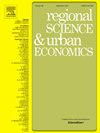合理削减?关闭规模不足的学校对当地的影响
IF 2.9
2区 经济学
Q1 ECONOMICS
引用次数: 0
摘要
公共教育服务的可用性会影响居住选择。因此,旨在通过减少公立学校网络中规模不足的节点数量来 "合理化 "提供服务的政策会导致人口下降,尤其是在空间上与外界隔绝、缺乏有效替代被取消服务的地区。本文利用意大利教育改革导致的学校网络收缩,研究了小学关闭对人口和收入的影响。我们评估了学校关闭是否会影响家庭的居住选择,以及是否会超过促使学校关闭的原有负面人口趋势。我们的研究结果表明,受学校关闭影响的城市的人口和收入会大幅减少。受影响的主要是远离经济中心、距离下一所小学较远的周边城市。这些证据表明,学校 "合理化政策 "会导致边缘地区人口减少,从而影响家庭和收入的空间分布,进而影响地区差距。本文章由计算机程序翻译,如有差异,请以英文原文为准。
Rational cuts? The local impact of closing undersized schools
The availability of public education services can influence residential choices. Therefore, policies aimed at ‘rationalising’ service provision by reducing the number of undersized nodes in the public school network can lead to population decline, especially in spatially isolated areas lacking valid alternatives to the removed services. This paper examines the demographic and income effects of primary school closures by exploiting an Italian education reform that resulted in the contraction of the school network. We assess whether school closures impact households’ residential choices, over and above preexisting negative population trends that motivate school closures. Our findings indicate that municipalities affected by school closures experience significant reductions in population and income. The effect is primarily driven by peripheral municipalities located far away from economic centres and distant from the next available primary school. This evidence indicates that school ‘rationalisation policies’, by fostering depopulation of peripheral areas, have an influence on the spatial distribution of households and income, thus affecting territorial disparities.
求助全文
通过发布文献求助,成功后即可免费获取论文全文。
去求助
来源期刊

Regional Science and Urban Economics
Multiple-
CiteScore
5.30
自引率
9.70%
发文量
63
期刊介绍:
Regional Science and Urban Economics facilitates and encourages high-quality scholarship on important issues in regional and urban economics. It publishes significant contributions that are theoretical or empirical, positive or normative. It solicits original papers with a spatial dimension that can be of interest to economists. Empirical papers studying causal mechanisms are expected to propose a convincing identification strategy.
 求助内容:
求助内容: 应助结果提醒方式:
应助结果提醒方式:


